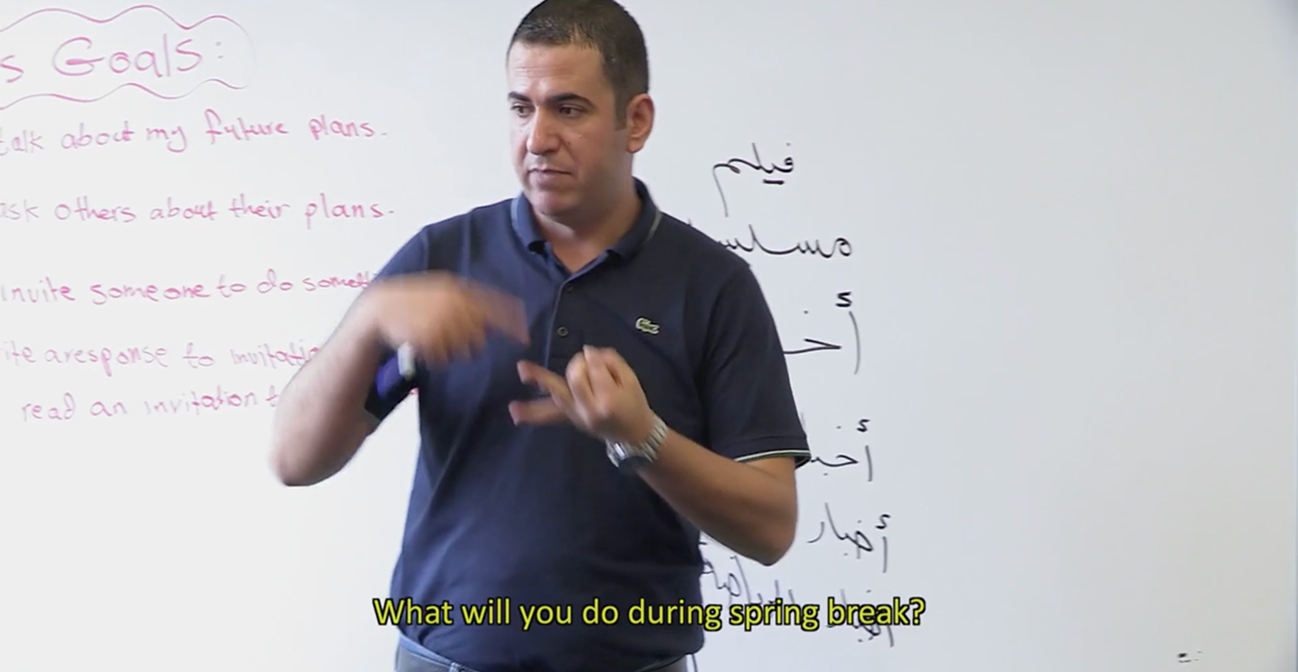Join us for conversations that inspire, recognize, and encourage innovation and best practices in the education profession.
Available on Apple Podcasts, Spotify, Google Podcasts, and more.

CLASSROOM AT A GLANCE
Teacher
Katie Quackenbush
Language
Arabic I
Grades
8
School
Boston Latin Academy, Boston, Massachusetts
Lesson Date
May 8
Class Size
14
Schedule
47 minutes daily
اضغط هنا للترجمة باللغة العربية
In this lesson, eighth graders in Katie Quackenbush’s Arabic I class continue a unit on hobbies and practice asking and answering questions using “you” and “I.” Ms. Quackenbush reviews the lesson agenda with the class and starts students off with a speaking activity in which students in groups pass around a paper bag as music plays. When the music stops, the student holding the bag picks a card from the bag and asks a classmate whether he or she likes doing the activity pictured on it. Ms. Quackenbush assesses student understanding of unit vocabulary and subject-verb agreement in their questions and responses, and provides corrective feedback. After the game, students survey classmates about whether they enjoy doing certain activities in their free time and create a bar graph using the data they have collected. Then Ms. Quackenbush tells students that in the next class they will compare their free-time activities with those of students in Saudi Arabia.
Communication: Interpersonal, Interpretive
Comparisons: Language
dialect
A form of a language used among people who live in the same geographical area or who share the same social identity. While language instruction traditionally emphasizes a “standard” form of a language, to more effectively communicate linguistically and culturally, instruction should also incorporate dialect elements within the curriculum to reflect the actual/authentic ways in which people communicate day-to-day.
learner-centered classroom
A classroom in which a teacher works with students to develop, implement, and evaluate learning goals based on students’ interests and unique needs. In this way, students have a voice not only in what they learn but also in why, when, how, and with whom they learn it. In a learner-centered classroom, the teacher facilitates rather than instructs, allowing learners greater opportunity to collaborate with peers in the target language.
thematic units
Thematic units are designed using content as the organizing principle. Vocabulary, structures, and cultural information are included as they relate to the themes in each unit. For an excellent example of theme-based units, see the Nebraska Foreign Language Education Web site in General Resources.
Reflect on Your Practice
As you reflect on these questions, write down your responses or discuss them as a group.
Watch Other Videos
Watch other videos in the Teaching Foreign Languages K–12 library for more examples of teaching methodologies like those you’ve just seen. Note: All videos in this series are subtitled in English.
Put It Into Practice
Try these ideas in your classroom. Where it’s not already evident, reflect on how to adapt an idea that targets one performance range for application to other performance ranges.
World-Readiness Standards for Learning Languages
The World-Readiness Standards for Learning Languages create a roadmap to guide learners to develop competence to communicate effectively and interact with cultural understanding. This lesson correlates to the following Standards:
Interpersonal Communication
Interpretive Communication
Learners understand, interpret, and analyze what is heard, read, or viewed on a variety of topics.
Language Comparisons
Lesson Materials
اضغط هنا للترجمة باللغة العربية
Lesson Agenda (PDF)
Slides that Ms. Quackenbush presented and reviewed with students at the beginning of the class
Do Now Graph: What Saudi Arabians Do in Their Free Time (PDF)
A bar graph with questions for student data interpretation
Free-Time Poll: Instructions and Interview Chart (PDF)
Instructions for interviewing classmates about their free-time activity preferences, and a chart for recording data
Free-Time Poll: Bar Graph Handout and Samples (PDF)
A blank graph with instructions for plotting interview data, and samples of student work
Infographic Miniproject: Assignment and Samples (PDF)
Instructions for completing the infographic miniproject assignment, and samples of student work
Curriculum References
Massachusetts Foreign Language Curriculum Framework (Aug. 1999)
Katie Quackenbush’s Additional Resources
Web Resources:
Al Jazeera: Learning Arabic
A source for simplified news articles. Each news article is accompanied by vocabulary words and different forms of assessment.
TeachMideast
This Middle East Policy Council website is useful for learning about the culture and history of various Arab countries. It’s also an excellent resource for research projects.
Arabic Signs of Foreign Words
This site presents a collection of photographs of foreign signs in the Arab World transliterated into Arabic.
Toyoraljanahtv
This YouTube channel contains a collection of songs and other videos geared to children.
Print Resources:
Standish, Sarah, Richard Cozzens, and Rana Abdul-Aziz. Jusoor: Beginning Arabic for High School (tentative title). Washington, DC: Georgetown University Press, forthcoming.